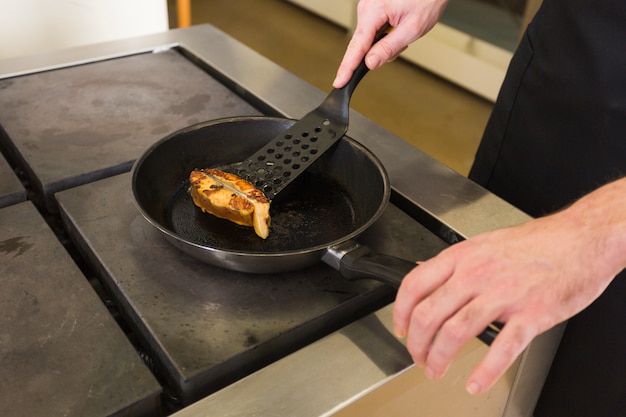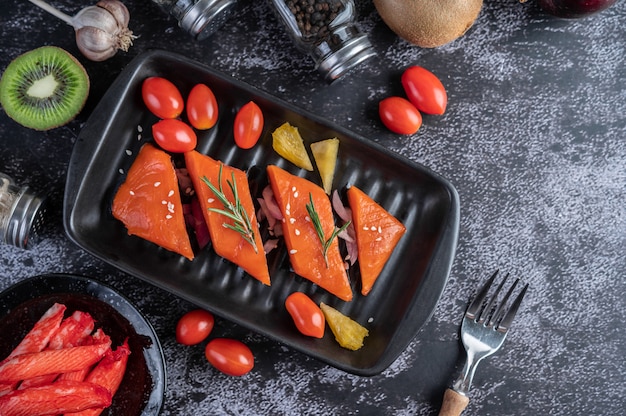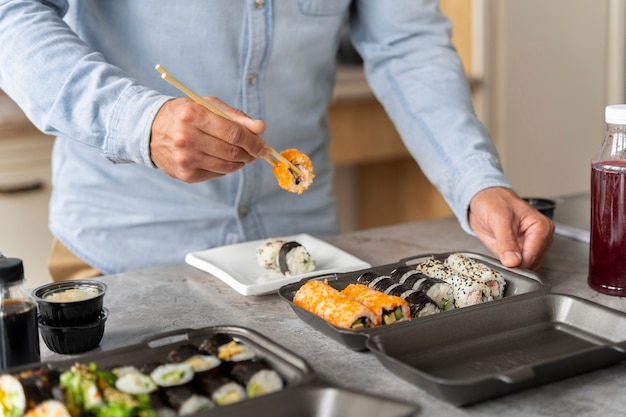There's something undeniably satisfying about a perfectly pan-seared salmon fillet. The golden-brown crust, the juicy, flaky flesh, the subtle smoky aroma – it's a culinary masterpiece that's surprisingly easy to achieve. And let's be honest, we all have those nights where we crave something delicious and healthy but don't want to spend hours in the kitchen. That's where pan-seared salmon comes in. It's a lifesaver, a quick and easy weeknight dinner hero that always impresses.
Now, I'm not claiming to be a Michelin-star chef (although, a girl can dream, right?), but I've cooked my fair share of salmon over the years. I've had my fair share of triumphs, and, let's be honest, a few flops too. But through trial and error, I've learned a thing or two about getting that perfect golden-brown crust and succulent, flaky flesh. So, grab a comfy seat, because I'm about to share all my secrets with you, my culinary comrades.
(Part 1) The Essentials: What You Need

Before we dive into the nitty-gritty of pan-searing, let's talk about what you'll need to make this culinary dream a reality. Trust me, it's a minimalist approach, making this recipe a breeze for even the busiest of cooks.
The Right Tools
You don't need a fancy kitchen gadget arsenal for this. Just a few trusty tools that you probably already have in your kitchen:
- A good quality, heavy-bottomed skillet: This is the foundation of your pan-searing success. I prefer cast iron for its heat retention and even cooking, but a sturdy stainless steel pan will do the trick. Just make sure it's big enough to comfortably hold your salmon fillets.
- A spatula: Your trusty sidekick for flipping your salmon and ensuring it doesn't stick to the pan. Opt for a thin, flexible spatula to easily slide beneath the delicate flesh.
- A meat thermometer: This is your secret weapon for guaranteeing perfectly cooked salmon. No one wants a dry, overcooked fish! Choose a digital meat thermometer for quick and accurate readings.
- Tongs: These are helpful for safely transferring the salmon to a plate once it's cooked. Look for tongs with a good grip and heat resistance.
The Perfect Ingredients
Now, let's talk about the stars of the show. This recipe is all about keeping it simple and fresh, with minimal ingredients to highlight the natural beauty of the salmon.
- Fresh salmon fillets: This is your starting point. Aim for wild-caught salmon if possible, but farm-raised is perfectly acceptable too. Just make sure the fillets are thick enough to avoid overcooking (about 1-inch thick). Look for fillets with bright, shiny skin and a slightly firm texture.
- Olive oil: Extra virgin, please! You want that nice, fruity flavour and high smoke point. Olive oil adds richness and moisture to your salmon while creating a delicious crust.
- Salt and pepper: Freshly ground, of course! These two are essential for enhancing the natural flavour of the salmon. Don't be shy, use a generous amount, especially for the salt.
- Lemon wedges: A touch of acidity and brightness is crucial to balance the richness of the salmon. Squeezing fresh lemon juice over the top adds a refreshing touch.
- Fresh herbs: This is where you can get creative! I love using dill, parsley, and chives, but you can use whatever you like. A bit of rosemary or thyme would also work beautifully. Remember, a little goes a long way.
(Part 2) Preparing the Salmon

Now that we've gathered our tools and ingredients, let's get ready to cook. This section is all about setting the stage for a perfect pan-seared salmon.
Pat it Dry, People!
The key to a perfect sear is to ensure your salmon is dry. Why? Moisture creates steam, which can prevent the skin from getting crispy. So, pat your fillets dry with paper towels, making sure to get all those little nooks and crannies. If you're using skin-on salmon, be sure to pat the skin side thoroughly.
Season with Love
Now comes the fun part: seasoning. Salt and pepper are essential, but don't be shy. You want a generous amount to really bring out the flavour of the fish. I like to sprinkle some fresh herbs over the top as well. Remember, a little goes a long way, so don't overdo it. You can also experiment with other seasonings like paprika, garlic powder, or a pinch of chili flakes if you like things a little spicy.
Skin Side Down
This is a crucial step, folks. Always sear your salmon skin-side down. This helps create that beautiful crispy crust and prevents the flesh from sticking to the pan. Think of it like this: the skin acts as a barrier, protecting the delicate fish underneath.
(Part 3) The Art of Searing

Now for the moment of truth! This is where the magic happens and your simple ingredients transform into a delicious meal.
Heat it Up!
Preheat your skillet over medium-high heat. You want it nice and hot, but not smoking. A good rule of thumb is to let the skillet heat for about 5 minutes. Once the pan is hot, add a generous drizzle of olive oil. The oil should shimmer and swirl when you tilt the pan. That's your cue to add the salmon. Don't be afraid to use enough oil. You want a thin layer covering the bottom of the pan to ensure even searing and prevent sticking.
Don't Move It!
Once the salmon is in the pan, resist the urge to poke it or move it around. Let it sit undisturbed for about 3-4 minutes. This will give the skin time to crisp up and develop a beautiful golden-brown colour. If it starts to stick, give it a gentle nudge with your spatula. But only if it's really stuck!
Flip and Finish
After 3-4 minutes, gently flip the salmon over using your spatula. Now you'll cook the other side for about 2-3 minutes, depending on how thick your fillets are. You want the flesh to be cooked through, but still moist and flaky. This is where your meat thermometer comes in handy.
(Part 4) Checking for Doneness
We're almost there, folks! Now it's time to ensure your salmon is perfectly cooked. Don't worry, it's easier than you think.
The Thermometer Test
Once your salmon has cooked for about 2-3 minutes on the second side, insert the meat thermometer into the thickest part of the fillet. The internal temperature should be around 145°F (63°C) for a perfectly cooked salmon.
The Flaky Test
If you don't have a meat thermometer, you can use the flaky test. Gently press the flesh with a fork. If it flakes easily, it's done. If it's still firm, it needs a little more time. But don't overcook it! overcooked salmon is dry and tough.
(Part 5) Serving with Flair
Your pan-seared salmon is ready! It's time to dress it up and present it with a touch of culinary elegance.
Rest and Garnish
Once your salmon is cooked to perfection, transfer it to a plate and let it rest for a couple of minutes. This will allow the juices to redistribute, resulting in a more tender and flavourful fish. While the salmon is resting, squeeze some lemon juice over the top and sprinkle with your favourite herbs. I like to add a pinch of salt and pepper for good measure.
side dish Pairings
The beauty of pan-seared salmon is its versatility. It goes well with a wide range of side dishes. Here are a few of my favourites:
- Roasted vegetables: Think asparagus, broccoli, Brussels sprouts, or sweet potatoes. Roasted vegetables add a delicious contrast in texture and colour to your salmon.
- Green salad: A simple salad with mixed greens, vinaigrette, and maybe some crumbled feta cheese. A light and refreshing salad balances the richness of the salmon.
- Quinoa: A light and fluffy grain that complements the salmon beautifully. Quinoa adds a healthy and protein-rich element to your meal.
- Rice: A classic pairing that never goes out of style. Rice provides a neutral base for the salmon's flavour to shine.
- Pasta: For a heartier meal, try serving your salmon with a simple pasta dish, like spaghetti with pesto or angel hair with garlic and oil. Pasta adds a satisfyingly hearty element to your salmon dinner.
(Part 6) Tips and Tricks
Now that you're armed with the basics, let's explore some additional tips and tricks to take your pan-searing game to the next level.
Skin-on vs. Skin-off
Personally, I prefer to cook my salmon with the skin on. It helps to keep the fillets moist and adds a bit of texture. Plus, the skin acts as a barrier, preventing the flesh from sticking to the pan. However, if you prefer, you can remove the skin before cooking. Just make sure to pat the fillets dry and sear them on the flesh side first.
Don't Overcrowd the Pan
If you're cooking multiple fillets, make sure you don't overcrowd the pan. This will prevent the salmon from cooking evenly and can lead to steaming rather than searing. If you have a small pan or a lot of salmon, cook in batches. It's better to cook in smaller batches to ensure even searing and avoid over-steaming the salmon.
Use a Good Quality Oil
As I mentioned earlier, I prefer extra virgin olive oil for its flavour and heat tolerance. But you can also use avocado oil, grapeseed oil, or even butter. Just make sure the oil has a high smoke point to prevent it from burning. Avoid using oils with low smoke points like canola oil, as they can burn easily and impart an unpleasant taste to your salmon.
Experiment with Flavors
Don't be afraid to experiment with different flavours! You can add a sprinkle of paprika, chili flakes, or garlic powder to your salmon before searing. Or, try a citrus zest like lemon, lime, or orange. The possibilities are endless!
Don't Be Afraid to Overcook (Slightly)
This might sound counterintuitive, but I find that a slightly overcooked salmon is better than an undercooked one. A little bit of dryness is preferable to the risk of food poisoning. However, you want to find the sweet spot: cooked through but still juicy. Remember, salmon is best cooked medium or medium-well, to ensure it's safe to eat.
(Part 7) salmon mistakes to Avoid
We all make mistakes in the kitchen, but some are more common than others. Here are a few salmon sins to avoid:
The Overcooked Salmon
We've all been there. You're so excited to eat your salmon, you forget about it on the stove and it ends up dry and tough. To avoid this, use a meat thermometer or the flaky test to check for doneness. And don't be afraid to take it off the heat a little early. Salmon is delicate, so keep a close eye on it during the cooking process.
The Sticky Salmon
This is usually due to a lack of oil or not enough heat. Make sure your pan is hot enough and generously drizzle with oil before adding your salmon. If it starts to stick, gently nudge it with your spatula, but don't force it. Ensure the pan is hot enough to allow the salmon to sear and create a crust without sticking.
The Soggy Salmon
If your salmon is cooked in a pan that isn't hot enough, it won't sear properly and will end up soggy. Make sure your pan is hot before you add the salmon, and don't overcrowd it. You want the salmon to sizzle, not steam. Make sure your pan is screaming hot to create that beautiful sear and prevent the salmon from becoming soggy.
(Part 8) FAQs
Let's clear up some common questions about pan-searing salmon.
1. Can I cook frozen salmon?
While you can technically cook frozen salmon, it's not ideal. Frozen salmon tends to be a little more mushy and can fall apart easily. If you must cook frozen salmon, make sure to thaw it completely before cooking and pat it dry. It's best to use fresh or thawed salmon for pan-searing to achieve the best results.
2. What's the best way to store leftover salmon?
Refrigerate leftover salmon in an airtight container for up to 3 days. You can reheat it in the oven, microwave, or skillet. It's best to reheat salmon gently to avoid overcooking and drying it out.
3. Can I make this recipe ahead of time?
While it's best to cook your salmon fresh, you can prepare it ahead of time. Season the fillets and refrigerate them for up to 24 hours. When you're ready to cook, simply remove them from the refrigerator and pat them dry before searing. Prepping ahead of time can save you time in the kitchen, but remember to cook it fresh for the best flavour.
4. Can I use different herbs?
Absolutely! Experiment with your favourite herbs. Some popular choices include rosemary, thyme, oregano, tarragon, and chives. Feel free to get creative and try different flavour combinations.
5. What if I don't have a meat thermometer?
If you don't have a meat thermometer, you can use the flaky test. Gently press the flesh of the salmon with a fork. If it flakes easily, it's done. If it's still firm, it needs a little more time. The flaky test is a good alternative to a thermometer, but it requires a little more experience.
Conclusion: Embrace the Pan-Seared Salmon
There you have it, folks! The ultimate guide to pan-searing salmon. It's simple, it's delicious, and it's guaranteed to impress your friends and family. So, next time you're looking for a quick and easy meal, give this recipe a try. Trust me, you won't regret it. And, remember, even if you don't get it perfect the first time (we all have our off days), keep practicing. You'll be a pan-seared salmon pro in no time!
Everyone is watching

Prime Rib Roast Cooking Time Chart: Per Pound Guide
Cooking TipsPrime rib roast. Just the name conjures images of lavish dinners, crackling fires, and hearty laughter. It’s ...

How Long to Bake Potatoes in the Oven (Perfect Every Time)
Cooking TipsBaked potatoes are a staple in my kitchen. They're incredibly versatile, delicious, and surprisingly easy to m...

Perfect Rice Every Time: The Ultimate Guide to Cooking Rice
Cooking TipsAs a self-proclaimed foodie, I've always been a bit obsessed with rice. It's the foundation of countless cuisi...

The Ultimate Guide to Cooking Asparagus: Tips, Techniques, and Recipes
Cooking TipsAsparagus. The mere mention of this spring delicacy conjures up images of vibrant green spears, crisp and burs...

Ultimate Guide to Cooking the Perfect Thanksgiving Turkey
Cooking TipsThanksgiving. Just the word conjures up images of overflowing tables laden with delicious food, the scent of r...
